Introduction
The little town of Gerolstein is situated in the middle of the Eifel Mountains in Rhineland-Palatinate, Germany and is part of nature- and geopark Vulkaneifel (Fig. 1), a region well known for its Quaternary volcanoes and maars.
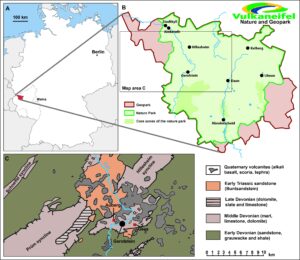
Figure 1. A) Germany with the Vulkaneifel district. B) Nature and Geopark Vulkaneifel. C) Simplified geological map (redrawn from Struve et al. 2008) of the Gerolstein area with the locations of Gees and Auberg; abbreviations: G.S. – Gerolstein syncline, SW. – Salmerwald syncline, D.S. – Dollendorf syncline.
Gerolstein and its surroundings are also famous for their Middle Devonian fossils, attracting countless amateur and professional geologists over the past two centuries, including famous visitors like Alexander von Humboldt, Leopold von Buch, Georg A. Goldfuss, and Sir Roderick I. Murchison to name a few (Kowalski 1990b). Particularly, the trilobites and crinoids (Fig. 2A–C) of Gerolstein were highly desired and are famous worldwide for their extraordinary preservation and diversity, with numerous new species described and unique to this area.
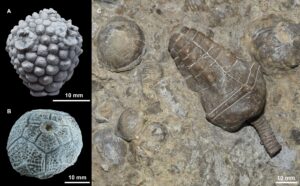
Figure 2. Crinoids from the Givetian of Gerolstein. A) Melocrinites gibbosus (Goldfuss 1831), “Mühlwäldchen marl”, limit of Ahbach and Loogh Formation. B) Sphaerocrinites sp., Loogh? Formation, Gerolstein. C) Halocrinites abbreviatus (Goldfuss 1838), Daasberg, Loogh Formation; all photos E. Rieker.
Richter and Richter (1930) passed on a remarkable little tale: according to them, the famous German naturalist Alexander von Humboldt visited Gees in 1845. He found so many fossils, including trilobites, that the pockets of his tailcoat were full, and he asked some astonished countrywomen to sell him their long wool socks for the transport of his treasures. This tale illustrates the abundance of fossils at that time, allowing the local teacher and geologist Stefan Dohm in the early 20th century to establish a flourishing fossil business in Gerolstein. He also founded together with the hotelier Jakob Heck the first “geognostic” museum of the Eifel, with an exquisite fossil exhibition in the Hotel Heck, making Gerolstein together with his son Batti Dohm a center of paleontological research and early geotourism. He provided many of his best specimens to Rudolph and Emma Richter, the leading German trilobite specialists of that time, and they honored Stefan Dohm by naming a species after him, Proetus dohmi Richter & Richter, 1918b. This species was later chosen by Lütke (1990) as type species of the new genus Dohmiella. In addition, the beautiful horn coral Dohmophyllum Wedekind, 1923 was named after him.
Numerous trilobites from Gerolstein and especially from Gees, a village nearby, were prepared with state-of-the-art techniques by S. Dohm and his collaborators and found their way into many museums and private collections around the world (B. Dohm 1930), establishing the fame of Devonian trilobites from the Eifel that still lasts today (Sam M. Gon III, Trilobites of Gees, http://www.trilobites.info/Gees.htm). In this context, it should be noted that the trilobite Teichertops battidohmi (Struve 1982) from the Loogh Formation (Givetian) of Gerolstein, originally assigned to Geesops, was named to honor Batti Dohm. Names like Geesops, the most common trilobite genus found in Gees, are still well known among trilobite enthusiasts. Furthermore, also a small rare trilobite genus of the order Lichida called Eifliarges was found at Gees and is named after the Eifel. It is, therefore, no coincidence that the lower Middle Devonian stage of the global stratigraphy was named the Eifelian after the Eifel, with the type section (GSSP) for the boundary of the Emsian (Lower Devonian) and Eifelian situated in the nearby Prüm syncline at Schönecken (Ziegler & Klapper 1985). The Eifel is the place to go for someone who wants to study Eifelian fossils and stratigraphy!
Literature review
The number of papers dealing with the trilobites of the Gerolstein area is huge, particularly those from the classical trilobite locality of Gees. Early pioneers were Bronn (1825), Steininger (1831), Goldfuss (1839, 1843), and Burmeister (1843), who described several new and important taxa, like Asteropyge punctata (Steininger 1831), Phacops latifrons (Bronn 1825), Cornuproetus cornutus (Goldfuss 1843) and Harpes macrocephalus Goldfuss, 1839. All these taxa are type species of genera that became name-givers for (sub)family names or even orders, e.g., Asteropyginae, Cornuproetinae, Phacopida, and Harpetida.
Great contributors to knowledge of the Gees trilobites include the world-famous trilobitologists Rudolf and Emma Richter, with an impressive number of publications (e.g., Richter 1909, 1914; Richter & Richter 1917a, b, 1918a, b, 1919, 1930, 1956a, b). A paper about new species of the genus Cyphaspis from Gees was published by Erben (1953). Additional work about proetid trilobites was provided by Lütke (1990), who in his review of the phylogeny of the Proetinae also handled material from Gerolstein. Highly important are the contributions of Struve (1970, 1972, and 1982) about new species and genera of the Phacopidae, in parts, also based on material from Gerolstein and Gees. Wolfgang Struve was another famous German trilobitologist, who worked for decades with his main research focus on the Eifel, particularly the trilobites and brachiopods were his specialty. He provided deep insights into the detailed stratigraphy (Struve 1996a. b; Struve et al. 2008), paleontology and paleoecology of the Middle Devonian in the Eifel. Bruton & Haas (1997) published results on the functional morphology of phacopids, based in parts on material collected in Gees. The amateur paleontologist Heinz Kowalski published numerous papers about paleontological topics of the Eifel, including several popular science publications about trilobites from the Gerolstein area (Kowalski 1974, 1975, 1978, 1982, 1985, 1986, 1989a, b, 1990a, b). Additional information about the famous spiny trilobite Ceratarges armatus (Fig. 3A–C), first described from Gees by August Goldfuss in 1839, was introduced by the Eifel-collector Norbert Höller in 1987, who figured some impressive specimens from his collection.
Among current researchers, Martin Basse is one of the few still active German trilobitologists, and he published four excellent and highly valued volumes about the trilobites of the Eifel (Basse 2002, 2003, 2006; Basse & Müller 2004). Rückert & Klever (2007) provided a good overview about the trilobite fauna of Gees, figured numerous species as complete specimens, and described four new species, one of which was considered by van Viersen et al. (2009a) to be a synonym of Cornuproetus cornutus. Some of the rarest spiny trilobites known from Gees are figured, e.g., complete specimens of Koneprusia, Radiaspis and Ceratarges. Led by the Dutch amateur paleontologist Allart van Viersen, several more new species of Dohmiella, Tropidocorype and Loreleiops (Fig. 3D) from the Gerolstein area were described and/or revised (e.g., Cyphaspis ceratophthalma, Fig. 3E–F) by van Viersen & Prescher (2007, 2008, 2010), van Viersen, Prescher & Savelsbergh (2009a, b), van Viersen & Holland (2016), and van Viersen, Taghon & Magrean (2017).
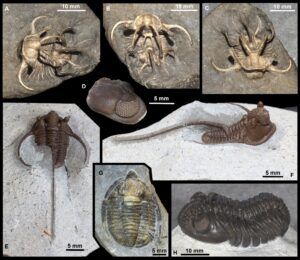
Figure 3. Trilobites of Gees, Ahrdorf Formation, middle Eifelian. A-C) Ceratarges armatus (Goldfuss 1839), NKM Gerolstein, preparation J. Koppka, photos E. Rieker. D) Loreleiops hoelleri (van Viersen, Prescher & Savelsbergh, 2009), holotype cephalon, Museum of Natural Sciences Brussels (IRSNB a12671), photo AvV. E-F) Cyphaspis ceratophthalma (Goldfuss, 1843), neotype (designated by van Viersen & Holland 2016), IRSNB a13017, photos AvV. G) Diademaproetus menzeni (Kowalski 1975), coll. F. Bachem, photo AvV. H) Geesops schlotheimi (Bronn 1825), adult specimen, NKM Gerolstein, preparation J. Koppka, photo E. Rieker.
Geological setting
The Middle Devonian sediments in the Eifel, geologically a part of the Rhenish Massif, are restricted to the subsidence area of the Eifel North-South-Zone. Eleven NE-SW oriented limestone synclines survived post-Variscan erosion and can be found in the region between Salm in the South and Sötenich in the North (Meyer 2013). The Gerolstein syncline (Fig. 1C) is one of the smaller synclines with a length of ca. 12 km and a maximal width of 5 km (Dohm 1930); it is situated in the southern part of this subsidence area and is surrounded by Lower Devonian sandstones and shales. It is the only limestone syncline which fits fully in the Geopark Vulkaneifel (Fig. 1A–C). Parts of the Gerolstein syncline are covered by red sandstones (Buntsandstein) of the Lower Triassic and in a larger degree by Quaternary volcanic deposits. The landscape of Gerolstein is dominated by imposing outcrops of dolomite cliffs (former reef limestones) facing the river Kyll, e.g., Munterley, Hustley and Auberg, and reaching heights of up to 100 m above the town. These massive and uniform dolomite rock formations have a stratigraphic range from the middle Eifelian (upper Junkerberg and Freilingen Formations) to the Givetian (Loogh, Cürten, Dreimühlen and Rodert Formations) (Winter 1965). The dolomites constitute the center of the syncline towering above older strata due to their resistance to erosion.
The trilobite fields of Gees (Ahrdorf Formation, middle Eifelian)
Trilobites occur in all Middle Devonian formations in the Gerolstein area; however, they have been most abundantly found - even as complete specimens - on the so-called “Trilobitenfelder” (trilobite fields) along the “Pelm-Salm way” (Fig. 4) of Gees (1 km east of Gerolstein). These fields are situated on the southern border of the central Gerolstein Syncline, at about 750 m west to 1250 m WSW of the village center of Gees (topographic map sheet Hillesheim, between r.2549320/h.5565260 and r.2548813/h.5564669) (van Viersen et al. 2009a).
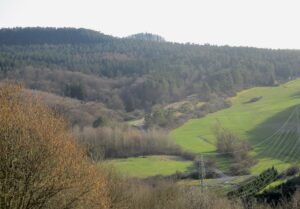
Figure 4. “Gees trilobite fields” along the Pelm-Salm way (asphalt road in the center), view from the Barley volcano hill, photo J. Koppka.
The fossiliferous beds belong to the middle Eifelian Ahrdorf Formation (Fig. 5) and trilobites are found in several members (Köll, Flesten and Wasen Members) of the Gees Subformation (Struve et al. 2008). This ca. 60 m-thick series is characterized by intercalations of limestone beds with marls, with varying proportions of fine sands and silt (van Viersen et al. 2009a). Volcanic activity existed already in Middle Devonian times in this area, manifested by several ash layers within the section, ranging from the Apus to Andromeda bentonite horizons (Winter 2001). They allow together with the trilobite associations a good correlation with the neighboring Prüm and Hillesheim synclines.
The upper part of the Flesten Member and the lower Wasen Member, characterized by nodular limestones banks and nodule beds, which are embedded within a thick formation of yellowish-grey marls, were the source for the majority of new trilobite species discovered in the Gerolstein area (Fig. 5). According to van Viersen et al. (2009), these trilobite beds are up to 25 m thick and can be divided into at least three subunits. However, these layers are today not exposed and covered by patches of forest, nutrient-poor grassland and juniper bushes as part of a valuable biotope. In the past, generations of trilobite enthusiasts worked on the trilobite fields. Unfortunately, in the 1980s the area became too much frequented by fossil collectors, who had transformed the site into a “cratered war zone”. The authorities were forced to ban further collecting in 1984, by protecting the 17.5 ha-large area in 1987 as a nature reserve (Ostermann 1990). Any collecting and even trespassing into the protected region has been strongly forbidden since then.
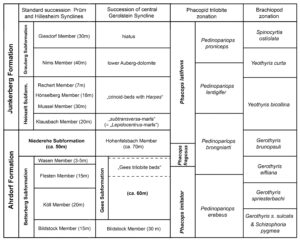
Figure 5. Overview of the local litho- and biostratigraphy for the Middle Eifelian Ahrdorf and Junkerberg Formations, Eifel; compiled after Struve (1996a, b), Struve et al. (2008), and van Viersen et al. (2009a, b).
Despite the prolonged collecting activities at Gees, relatively little was known about the detailed stratigraphy of the site and details of the trilobite species distribution of the section. A stratigraphic section log was never published. So far, the only accurate, although incompletely published, data were obtained through excavations in 1998 and 1999 (Lueken in Winter 2001). Led by Prof. Winfried Haas from the University of Bonn, the lower and middle sections of the fossiliferous strata were investigated and a deep trench of about 20 m length was excavated. Every bed was documented and sampled, especially for trilobites with the help of local collectors. Unfortunately, the project appears to have ended shortly after the retirement of Prof. Haas in 1998, with the collected samples remaining unstudied so far.
However, thanks to the short review of Basse and Müller (2004), who listed 35 species, we have an overview of the known trilobite fauna of Gees. A few more species like Loreleiops hoelleri (Fig. 3D), Tropidocoryphe bassei (Fig. 7A), Koneprusia lukiana and Asteropyge longispina extend this already impressive species list (Appendix A).
Generally, it can be said that Geesops schlotheimi (Bronn, 1825) is the most common trilobite in Gees, occurring throughout the whole section with an abundance of up to 90% of all trilobite finds. Interestingly, most of the Geesops specimens are small and enrolled, and even tiny juveniles exist (Fig. 7B). Large, adult specimens are very rare; when are found they can reach an outstretched length of up to 5 to 6 cm (Fig. 3H). For this reason, there has been speculation among collectors that the area around Gees may have been comparable to a “kindergarten facies” or “nursery ground”, a preferred hatching ground for Geesops (Kowalski 1974) and some other trilobite species with unusually small-sized individuals.
Many of the enrolled Geesops specimens show a slight disarticulation of the pygidium. This distortion was observed and figured by Bruton and Haas (1997), who cut 30 specimens of Geesops schlotheimi and G. sparsinodosus. Their material from Gees used for a functional morphology study on phacopids was acquired from Stephan Dohm in the 1920s. They explained the distortion phenomenon by a gravitational collapse (implosion), moving the pygidium into the void (after the decay of the soft parts) during early diagenesis. However, enrolment in trilobites was a protective movement, as seen in modern woodlice and indicates that the animals felt threatened during the time they were buried. They concluded that the trilobites enrolled before rapid burial happened, linked to an obrution event (Bruton and Haas 1997), such as a mudslide or a cloud of fine sediment transported by heavy storms. However, layers with enrolled specimens often show a wide variety of other trilobite species also in a complete state of preservation, e.g., Cyphaspis ceratophthalma (Fig. 3E-F, neotype), Gerastos cuvieri, Cornuproetus cornutus, Asteropyge punctata, and Neometacanthus stellifer as well as other relatively common trilobites. These species are all genus type species, illustrating the importance of Gees (see Appendix A for a complete annotated species list).
Among the most famous trilobites of Gees are the strongly spiny, horned trilobites (Richter & Richter 1930), like Radiaspis radiata, Eifliarges caudimirus, Kettneraspis elliptica, and the already mentioned Ceratarges armatus. One complete Ceratarges specimen (Fig. 3A–C) collected in the early 1980s was recently prepared by the author. Remarkable is its strongly arched condition, with head and pygidium nearly touching each other (Fig. 3B). A bent position is not untypical for a Ceratarges, showing the high flexibility of the thorax, but it may also dramatically illustrate a futile attempt to get free from the entombing sediment. Another remarkable aspect of this specimen is the different lengths of its stalked eyes; the left one is only half as long as the right one, and unnaturally out of line because of a healed injury from a predation attempt (Fig. 3C). Pathologies are relatively common for Ceratarges specimens of Gees (pers. communication M. Walter), indicating a benthic mode of life with a high risk of being attacked by predators.
Auberg site (Junkerberg Formation, middle Eifelian)
The Auberg hill in Gerolstein, in the old literature and maps also called Auburg (e.g., Rauff 1911, Dohm 1930) because of its castle-like appearance, is situated next to the old Sarresdorf village (now part of Gerolstein). The impressive natural rock formation consists of five large pillars of dolomite (Fig. 6), the Auberg dolomite (Krömmelbein 1957), a local equivalent to the upper Junkerberg (here called lower Auberg dolomite, Fig. 5) and lower Freilingen Formations (middle to late Eifelian), which are developed in the Gerolstein area with a thickness of more than 100 m (Meyer 2013). Although the Auberg dolomite is fossiliferous, and may even contain occasional trilobites, e.g., Hypsipariops cf. kowalskii as found in Gerolstein in the Freilingen Formation, the dolomitization of the former limestone destroyed most of its fossil content. Some remains of stromatoporoids (laminated calcareous sponges) can be found, but the characteristic fossiliferous Giesdorf Member with the brachiopod Spinocyrtia ostiolata of the uppermost Junkerberg Formation is not developed in the Gerolstein area and probably missing due to a hiatus (Winter 1968). The limit between the Junkerberg and Freilingen Formations is therefore difficult to determine because of the homogeneous lithology of the dolomite.

Figure 6. Auberg, view from the west, photo E. Rieker.
However, the main trilobite-bearing strata are older and belong to the middle parts of the Junkerberg Formation. They are known in the older literature as “crinoid beds with Harpes” (Rauff 1911) and correspond likely with the Mussel to Rechert Members of the modern local stratigraphy (Fig. 5). The series consists of gray marls interbedded with thick limestone layers of unknown total thickness, containing large stromatoporoids with associated fine-grained and very hard “glass”-limestones. The trilobites occur in those hard limestones, but they are particularly in the case of Harpes difficult to find and even more challenging to prepare due to the hardness and stickiness of the limestone. Nowadays these fossiliferous strata are not exposed anymore and covered by grassland and forest.
The Auberg is in comparison to Gees the lesser-known trilobite locality of the Gerolstein area, but the hill is still famous for the relatively common occurrence of complete specimens of the above-mentioned Harpes macrocephalus Goldfuss, 1839, the type species of the genus. Although probable, it is not certain that the Auberg is also the type locality of this spectacular trilobite, characterized by a large cephalon with a semicircular brim. However, the site is a long-known trilobite locality, and clearly the area with the highest abundance of Harpes macrocephalus in the Eifel, which is noteworthy for an otherwise very rare species (Fig. 7C). Because of that, it is likely the place where the type material of Goldfuss (1839) originated.
Another famous trilobite is Phacops latifrons (Bronn 1825); again, this is the type species of the genus and, with unsure provenience, but it was likely found as well at the Auberg in Gerolstein (see discussion in Basse and Müller 2004). Bronn’s figured type specimen is an enrolled individual, and similar finds are indeed known from the Auberg, but extremely rare at any other site. Additional material was discovered in recent years during home site construction works along the southern rim of the hill. Among it, a complete and already isolated, loose specimen of P. latifrons was found by T. Paul (Fig. 7D).
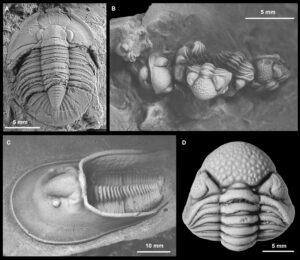
Figure 7. A-B: Trilobites of Gees, Ahrdorf Formation, middle Eifelian. A) Tropidocoryphe bassei van Viersen, Prescher & Savelsbergh, 2009, holotype, Senckenberg (SMF 58518). B) Geesops schlotheimi (Bronn 1825), juvenile specimens aligned in a row, coll. F. Bachem. C) Harpes macrocephalus Goldfuss, 1839, Weinberg, Hillesheim syncline, Junkerberg Formation, Nimbs Member, coll. M. Walter. D) Phacops latifrons (Bronn 1825), Auberg, Junkerberg Formation, Rechert Member, coll. T. Paul, photo E. Rieker.
The importance of the site is illustrated by the numerous trilobite species that have been found at the Auberg in the past 200 years, with many of them having their type locality (LocT) there. The species known so far are Harpes macrocephalus Goldfuss, 1839 (LocT?), Goldius flabelliferum (Goldfuss 1839), Goldius aff. geesense Richter & Richter 1956a, Gerastos sp., Dohmiella dohmi Richter & Richter 1918b (LocT), Longiproetus tenuimargo (Rud. Richter 1909) (LocT), Astycoryphe senckenbergiana Richter & Richter 1919, Tropidocoryphe aff. endorfensis Basse 1997, Cyphaspis sp., Phacops latifrons Bronn 1825 (LocT?), Pedinopariops sp., Mephiarges mephisto (Richter & Richter 1918a) (LocT), and Koneprusia bucco (Richter &. Richter 1918a) (LocT).
Geoconversation and Geoeducation
Fossil collecting at the famous trilobite localities of the Gerolstein area is not possible any more. Before the final protection of the trilobite fields in Gees, the area was frequented by hundreds of collectors. This collection-tourism was benefiting local hoteliers, but the digging activities left a strong visual impact on the area that angered the local population and authorities. However, due to the strong protection, even scientists are not allowed today to access the site without special permission granted by the heritage authorities of the country. However, material from Gees and Gerolstein, collected before the protection, exists worldwide in many paleontological collections and museums around the world. In Germany, the material is widespread in numerous museums, and occasionally on display, e.g., in the show exhibition in the Senckenberg Museum in Frankfurt and the Natural History Museum of Gerolstein. A lot of additional material exists in universities and other museums (e.g., Bonn, Berlin, Greifswald, Brussels) or is owned by private collectors. Unfortunately, stratigraphic control for that material is usually lacking.
Gerolstein has a long geotouristic tradition. The Hotel Heck in Gerolstein exhibited a large and exquisite fossil collection (Dohm 1930, pls. 1-3), provided by Stefan Dohm and co-workers. The hotel was the place where many artists, geologists and fossil enthusiasts met. Unfortunately, it was destroyed, including the famous fossil exhibition, during the war, in 1944. Batti Dohm continued the work of his father after the early death of Stefan Dohm in 1924. He studied geology and wrote, back in Gerolstein, several books about local geology. Among them is a little novel written from the perspective of the trilobite Cyphaspis ceratophthalma. The title of this book by Batti Dohm (1933) is “Stielauge der Urkrebs” (Stalk-eye the primordial crab), and this novel is an early geo-educational highlight that introduces the local geology and paleontology to the interested public. In Gerolstein, the Natural History Museum, founded in 1987, values the famous fossils of the region and exhibits a large collection of trilobites found in Gees and the neighborhood of Gerolstein in the so-called “Trilobitarium”. In four cases, several hundred local trilobites are showcased, among them many rare species like the already mentioned Ceratarges armatus and the largest specimen of Diademaproetus menzeni (Fig. 3G), a species known in total from maybe just five specimens. Many of the best specimens in the exhibitions are loaned or donated by local trilobite collectors and we have to thank the initiative of those enthusiasts and the support of the town of Gerolstein that the museum was founded in the first place.
The museum in Gerolstein provides guided tours through the exhibition for groups, with the trilobites and other Devonian fossils as one of the highlights. For kids, several cute touchable mascots, made of papier mâché, like the trilobite Rudolph Phacops, or Oskar Dolomit and Willi Basalt, provide a unique experience and facilitate memorizing difficult-to-pronounce scientific names. Special programs for school groups exist, like the Georium, a three-hour course where the children get to see the exhibition and learn for instance how fossilization occurred. We demonstrate that in a box filled with sand and some recent shells. We add water and demonstrate how moving the box lets the shell disappear into the sand, when the moving water simulating a storm moves the sand. Later, they can dig in larger sand-filled wooden boxes hunting for fossils and gemstones, hidden in the sand. They can recover the “bedrock” made of gypsum with casts of different characteristic fossils of different time periods for every box, like the Jurassic, Cambrian, Carboniferous and naturally the Devonian as well. Each group gets a handout that explains the fossils in the boxes and they can report in the end what they have discovered. Another part of the program is kneading a salt play dough, which can easily be formed into fossils, like a simplified trilobite. We show how it is done and the children have fun trying it. The final result can be dried, later on, getting hard and durable in the process.
The museum provides also guided hiking tours for groups, presenting the many attractive places along the “Rock-path” leading to the Munterley, the Buchenloch cave and the volcano crater Papenkaule. On the hike, the Auberg can be seen and some explanations about the Devonian Period and the famous fossils of Gerolstein are given. Many tourists follow the famous 313 km-long hiking path “Eifelsteig”, which runs through the Eifel from Aachen to Trier. The Gerolstein stage is 25 km long and the trail includes a visit to the Auberg with its excellent view, and the Munterley. Along the trail, numerous information panels explain interesting geological and archeological aspects including the famous fossils of the Gerolstein Dolomites. The path also crosses the area close to the trilobite fields of Gees without further explanations on its way to the Dietzenley volcano hill, which was occupied by a small Celtic hill fort 2500 years ago.
Conclusions
The two famous trilobite localities Gees and Auberg of the Gerolstein area, each with over 200 years of research history, are among the classical paleontological sites of the world. The many new species and genera from those sites had a huge impact on our current understanding of Devonian trilobite diversity. However, it is frustrating how little we actually know today about the detailed stratigraphy and species distribution of both sites. There is basically very little stratigraphic control for the majority of the trilobite taxa and associated fauna, e.g., brachiopods, crinoids, in museums. Many questions are still unanswered, for instance, the reason for the complete disappearance of Geesops in the Junkerberg Formation. Perhaps because of environmental changes due to the shallower conditions or is it a sampling bias? More research is needed, but with the strong protection of both sites as nature reserves and part of the Geopark Vulkaneifel it will be difficult to achieve this. On the other hand, there is still unstudied material from the last scientific dig in Gees made by the University of Bonn, which could help to answer some of these questions.
Interested visitors may not be allowed to search for trilobites any more, but they can at least see many impressive specimens from the area in the Natural History Museum of Gerolstein, which is still sponsored by the town of Gerolstein and their citizens who are proud of their famous geological and fossil heritage.
Acknowledgments
I have to thank Allart van Viersen (AvV) for providing important information regarding the trilobite association found in Gees, including among others, the photographs of the neotype specimen of Cyphaspis ceratophthalma. Thanks to Ede Rieker who photographed together with the author several of the trilobite specimens figured here, from the collection of the Natural History Museum (NKM) in Gerolstein. Finally, I have to acknowledge the collectors G. Rieder, A. Rückert, M. Walter, F. Bachem, T. Paul, and D. Stump who provided valuable information for this paper and contributed fossil exhibits to the museum in Gerolstein.
Appendix A. Annotated list of the trilobite species from the trilobite fields of Gees
Scutelluidae
Scabriscutellum canaliculatum (Goldfuss, 1843), Locus typicus Gees, (= S. vogeli Archinal, 1994)
Goldius geesense (Richter & Richter, 1956), Locus typicus Gees
Goldius grafi (Basse in Basse & Müller, 2004), Locus typicus Gees
Thysanopeltella acanthopeltis (Barrande, 1852), Locus typicus Gees, type species
Phacopidae
Geesops schlotheimi (Bronn, 1825), Locus typicus Gees, type species
Geesops sparsinodosus (Struve, 1970)
Loreleiops hoelleri (van Viersen, Prescher & Savelsbergh, 2009), Locus typicus Gees, type species
Phacops cf. imitator Struve, 1970
Phacops fragosus Struve, 1970
Pedinopariops brongniarti (Steininger, 1831), Locus typicus Gees
Pedinopariops laevus Rückert & Klever, 2007, Locus typicus Gees
Acastidae, Asteropyginae
Asteropyge comes Basse, 2003, Locus typicus Gees
Asteropyge longispina Rückert & Klever, 2007, Locus typicus Gees
Asteropyge punctata (Steininger, 1831), Locus typicus Gees, type species
Neometacanthus stellifer (Burmeister, 1843), Locus typicus Gees, type species
Cheiruridae
Crotalocephalus geesianus Basse, 2003, Locus typicus Gees
Proetidae, Proetinae
Gerastos cuvieri (Steininger, 1831), Locus typicus Gees, type species (= G. laevigatus Goldfuss, 1843)
Gerastos granulosus Goldfuss, 1843, Locus typicus Gees
Dohmiella chamaeleo (Richter & Richter, 1918b), Locus typicus Gees
Cornuproetinae
Cornuproetus cornutus (Goldfuss, 1843), Locus typicus Gees, type species (= C. hoffmannae Rückert & Klever, 2007)
Cornuproetus rhenanus (Basse, 2002), Locus typicus Gees
Diademaproetus menzeni (Kowalski, 1975), Locus typicus Gees
Tropidocoryphinae
Tropidocoryphe bassei van Viersen, Prescher & Savelsbergh, 2009, Locus typicus Gees
Tropidocoryphe sp.
Astycoryphe senckenbergiana Richter & Richter, 1919, Locus typicus Gees, type species
Aulacopleuridae
Cyphaspis ceratophthalma (Goldfuss, 1843), Locus typicus Gees, type species
Cyphaspis balanops (Erben, 1953), probably junior subjective synonym of C. ceratophthalma
Cyphaspis hoepfneri (Kowalski, 1990), Locus typicus Gees
Cyphaspis ranuncula (Erben, 1953), Locus typicus Gees
Lichidae
Eifliarges caudimirus (Richter & Richter, 1917), Locus typicus Gees, type species
Ceratarges armatus (Goldfuß, 1839), Locus typicus Gees, type species
Ceratarges berolinensis (Richter, 1909), Locus typicus Gees
Odontopleuridae, Odontopleurinae and Koneprusiinae
Charybdaspis comes Basse, 1998, probably junior subjective synonym of Radiaspis radiata
Radiaspis radiata (Goldfuss, 1843), probably Locus typicus Gees, type species
Kettneraspis elliptica (Burmeister, 1843), Locus typicus Gees
Kettneraspis aries (Richter, 1909), Locus typicus Gees
Koneprusia lukiana Rückert & Klever, 2007, Locus typicus Gees
Harpetidae
Harpes cf. macrocephalus Goldfuss, 1839
References
Basse M (1997). Trilobiten aus mittlerem Devon des Rhenohercynikums: II. Proetida (2), Ptychopariida, Phacopida (1). Palaeontographica A. 246(3-6): 53-142.
Basse M (2002). Eifel‐Trilobiten. 1. Proetida. Korb: Goldschneck‐Verlag.
Basse M (2003). Eifel‐Trilobiten 2. Phacopida 1. Korb: Goldschneck‐Verlag.
Basse M (2006). Eifel‐Trilobiten IV. Proetida (3), Phacopida (3). Wiebelsheim: Quelle & Meyer‐Verlag.
Basse M & Müller P (2004). Eifel‐Trilobiten 3. Corynexochida, Proetida (2), Harpetida, Phacopida (2), Lichida. Wiebelsheim: Quelle & Meyer‐Verlag.
Bronn H (1825). Ueber zwei neue Trilobiten-Arten zum Calymene-Geschlechte gehörig. Zeitschrift für Mineralogie. 1825(4): 317- 321.
Bruton D & Haas W (1997). Functional morphology of phacopinae (Trilobita) and the mechanics of enrolment. Palaeontographica. 245: 1-43.
Burmeister H (1843). Die Organisation der Trilobiten aus ihren lebenden Verwandten entwickelt; nebst einer systematischen Uebersicht aller zeither beschriebenen Arten. Berlin: G. Reimer.
Dohm B (1930). Die Kalkmulde von Gerolstein in der Eifel: eine Einführung in die Geologie. Wittlich: Georg Fischer Verlag.
Dohm B (1933). Stielauge der Urkrebs - Eine Chronik aus Urzeiten unserer Erde. Leipzig: Koehler & Amelang.
Erben HK (1953). Über einige Otarionidae (Tril.) aus dem Mittel‐Devon der Eifel. Senckenbergiana lethaea. 34: 73-80.
Goldfuss A (1839). Beiträge zur Familie der fossilen Crustaceen. Beiträge zur Petrefactenkunde. Verhandlungen der Kaiserlichen Leopoldinisch‐Carolinischen Academie der Naturforscher. 19: 353‐364.
Goldfuss A (1843). Systematische Übersicht der Trilobiten und Beschreibung einiger neuer Arten derselben. Neues Jahrbuch für Mineralogie, Geognosie, Geologie und Petrefaktenkunde. 1843: 537‐567.
Höller N (1987). Ceratarges armatus Goldfuss, ein Trilobit in zweierlei Gestalt aus dem Mitteldevon der Eifel. Aufschluss. 38: 349‐358.
Kowalski H (1974). Gerolstein - ein klassischer Fossilfundort. Aufschluss. 25(10): 540-552.
Kowalski H (1975). Cornuproetus (Diademaproetus) aus dem Eifelium (Mitteldevon) der Eifel. Aufschluß. 26: 97-101.
Kowalski H (1978). Die Trilobitentrift bei Gees – Ein weltberühmter Fossilienfundort. Eifel-Jahrbuch. 1979: 57-61.
Kowalski H (1982): Otarionidae vom Pelm-Salmer Weg bei Gees in der Eifel. Aufschluss. 33: 105-125.
Kowalski H (1985). Versteinerungen aus der Gerolsteiner Kalkmulde. Aufschluss. 36(12): 331-347.
Kowalski H (1986). Trilobiten vom Pelm‐Salmer Weg bei Gees (Eifel). Fossilien. 3: 225‐ 228.
Kowalski H (1989a).Trilobiten vom Pelm-Salmer Weg: Cornuproetinae. Fossilien. 1989(1): 31-37.
Kowalski H (1989b). Trilobiten vom Pelm‐Salmer Weg: Tropidocoryphinae. Fossilien. 1989(6): 272‐275.
Kowalski H (1990a). Trilobiten aus dem Devon der Eifel. Aufschluss, Sonderband. 33: 11‐ 63.
Kowalski H (1990b). Die Mitteldevon-Fauna von Gerolstein. In Weidert, W.K. 1990: Klassische Fundstellen der Paläontologie. Band II. pp. 18-27. Eichstätt: Goldschneck-Verlag.
Krömmelbein K (1957). Zur Gliederung des Devons der Gerolsteiner Mulde in der Eifel. Senckenbergian lethaea. 38: 359-367.
Lütke F (1990). Contributions to a phylogenetical classification of the subfamily Proetinae Salter 1864 (Trilobita). Senckenbergiana lethaea. 71: 1‐83.
Meyer W (2013). Geologie der Eifel. 4th ed. Stuttgart: E. Schweizerbart´sche Verlagsbuchhandlung.
Ostermann G (1990). Die Trilobitenfelder bei Gees. Heimat-Jahrbuch des Kreises Daun. 1991: 108-111.
Rauff H (1911). Entwurf zu einem geologischen Führer durch die Gerolsteiner Mulde. Berlin: Königlich geologische Landesanstalt.
Richter R (1909). Beiträge zur Kenntnis devonischer Trilobiten aus dem Rheinischen Schiefergebirge. Dissertation, University of Marburg.
Richter R (1914). Das Übergreifen der pelagischen Trilobitengattungen Tropidocoryphe und Thysanopeltis in das normale Rheinische Mitteldevon der Eifel (und Belgiens). Centralblatt für Mineralogie, Geologie und Paläontologie. 1914: 85‐96.
Richter R & Richter E (1917a). Die Lichadiden des Eifler Devons. Neues Jahrbuch für Geologie und Paläontologie. 1: 50‐72.
Richter R & Richter E (1917b). Über die Einteilung der Familie Acidaspidae und über einige ihrer devonischen Vertreter. Centralblatt für Mineralogie, Geologie und Paläontologie. 1917: 462‐472.
Richter R & Richter E (1918a). Paläontologische Beobachtungen im Rheinischen Devon. I. Über einzelne Arten von Acidaspis, Lichas, Cheirurus, Aristozoe, Prosocoelus, Terebratula und Spirophyton aus der Eifel. Jahrbücher des Nassauischen Vereins für Naturkunde. 70(1917): 143-161.
Richter R & Richter E (1918b). Neue Proetus‐Arten aus dem Eifler Mitteldevon. Centralblatt für Mineralogie, Geologie und Paläontologie. 1918: 64‐70.
Richter R & Richter E (1919). Der Proetidenzweig Astycoryphe - Tropidocoryphe - Pteroparia. Senckenbergiana. 1: 1-17, 25‐51.
Richter R & Richter E (1930). Neue Hörner‐Trilobiten in unserer Schausammlung. Natur und Museum. 60: 31‐45.
Richter R & Richter E (1956a). Grundlagen für die Beurteilung und Einteilung der Scutelluidae (Tril.). Senckenbergiana lethaea, 3 (1/2): 79-124.
Richter R & Richter E (1956b). Ergänzendes zu den Scutelluidae mit Ausblick auf den Sprossungs-Gürtel der Trilobiten. Senckenbergiana lethaea, 37(5/6): 467-485.
Rückert A & Klever T (2007). Trilobiten ‐ Schätze des Gerolsteiner Landes. Neroth: Verlag Eifelkrone Musik & Buch.
Steininger J (1831). Bemerkungen über die Versteinerungen, welche in dem Uebergangs-Kalkgebirge der Eifel gefunden werden. Beilage zum Gymnasial-Programmschrift zu Trier.
Struve W (1970). Beiträge zur Kenntnis der Phacopina (Trilobita), 7: Phacops-Arten aus dem Rheinischen Devon. 1. Senckenbergiana lethaea. 51(2/3): 133-189.
Struve W (1972). Beiträge zur Kenntnis der Phacopina (Trilobita), 8: Phacops-Arten aus dem Rheinischen Devon. 2. Untergattungs-Zuweisung. Senckenbergiana lethaea. 53(5): 383–403
Struve W (1982). Beiträge zur Kenntnis der Phacopina (Trilobita), 10. Neue Untersuchungen über Geesops (Phacopinae; Unter- und Mitteldevon). Senckenbergiana lethaea. 63(5/6): 473-495.
Struve W (1996a). Trilobiten, Rheinisches Schiefergebirge; Mitteldevon. In: K. Weddige, Devon- Korrelationstabelle, Spalte B 100dm96. Senckenbergiana lethaea. 76(1/2): 280.
Struve W (1996b). Brachiopoden, Rheinisches Schiefergebirge; Mitteldevon. In: K. Weddige, Devon- Korrelationstabelle, Spalte B 120dm96;. Senckenbergiana lethaea. 76(1/2): 280.
Struve W, Basse M & Weddige K (2008). Prädevon, Ober-Emsium und Mitteldevon der Eifeler Kalkmulden-Zone. Schriftenreihe der Deutschen Gesellschaft für Geowissenschaften, Stratigraphie von Deutschland VIII - Devon. 52: 297-374.
Viersen AP van & Holland D (2016). Morphological trends and new species of Cyphaspis (Trilobita, Otarioninae) in the Devonian of Morocco, Turkey, Germany and Belgium. Geologica Belgica. 19(3-4): 251-271.
Viersen AP van & Prescher H (2007). Note on Cyphaspis Burmeister 1843 (Trilobita, Aulacopleuridae), with a review of several species mainly from the Devonian of Belgium and Germany. Senckenbergian lethaea. 87(2): 157-170.
Viersen AP van & Prescher H (2008). Devonian Proetidae (Trilobita) from the Ardennes Massif (Belgium, N France) and the Eifel Hills (W Germany). Bulletin de l’Institut royal des Sciences naturelles de Belgique, Sciences de la Terre. 78: 9-29.
Viersen AP van & Prescher H (2010). Taxonomy and biostratigraphy of some proetid trilobites in the Middle Devonian of the Ardennes and Eifel (Rhenohercynian Zone). Bulletin de l’Institut royal des Sciences naturelles de Belgique, Sciences de la Terre. 80: 5-45.
Viersen AP van, Prescher H & Savelsbergh J (2009a). Description of two new trilobites from the Ahrdorf Formation (Middle Devonian) at the “Trilobitenfelder” of Gees, Eifel, Rhenish Mountains. Bulletin de l’Institut royal des Sciences naturelles de Belgique, Sciences de la Terre. 79: 43-53.
Viersen AP van, Prescher H & Savelsbergh J (2009b). Zwei neuen Trilobitenarten der Ahrdorf Formation (Mittel‐Devon) aus den „Trilobitenfeldern“ bei Gees (Gerolstein) in der Eifel. Aachen: self-published.
Viersen AP van, Taghon P & Magrean B (2017). The phacopid trilobites Austerops McKellar & Chatterton, 2009, Hottonops gen. nov. and Loreleiops gen. nov. from the Devonian of the Ardenno-Rhenish Mountains. Neues Jahrbuch für Geologie und Paläontologie, Abhandlungen. 283(1): 53-68.
Wedekind R (1923). Die Gliederung des Mitteldevons auf Grund von Korallen. Sitzungsberichte der Gesellschaft zur Beförderung der Gesamten Naturwissenschaften zu Marburg. 1922(4): 24-35.
Winter J (1965). Das Givetium der Gerolsteiner Mulde (Eifel). Fortschritte in der Geologie von Rheinland und Westfalen. 9: 277-322.
Winter J (1968). Freilingen-Schichten in der Gerolsteiner Mulde (Mitteldevon, Eifel). Senckenerbiana lethaea. 49: 595-607.
Winter J (2001). Tephrostratigraphische Korrelation bentonisierter air-fall Aschenlagen mit Zirkon-Morphocodes (Ahrdorf-Formation, Eifel). Senckenbergiana lethaea. 81(2): 407-429.
Ziegler W & Klapper G (1985). Stages of the Devonian System. Episodes. 8(2): 104-109.
